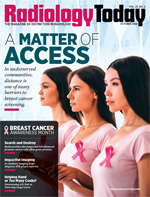 Ultrasound News: Meeting the Challenge
Ultrasound News: Meeting the Challenge
By Rebecca Montz, EdD, MBA, CNMT, PET, RT(N)(CT), NMTCB RS
Radiology Today
Vol. 23 No. 6 P. 34
Diagnostic ultrasound is a vital tool for monitoring maternal and fetal health. However, access to low-cost equipment is outpacing health care providers’ ability to be adequately educated and trained. Through its Ultrasound Proficiency Grand Challenge (UPGC) initiative, Inteleos, a nonprofit global health care certification organization, is working toward conquering maternal and fetal mortality rates in low-resource communities. The program aligns with the United Nations Strategic Development Goal 3.1: “Good Health and Well Being,” which includes reducing the global maternal mortality ratio to less than 70 per 100,000 live births by 2030. Therefore, it is a priority of Inteleos to ensure providers are receiving proper training to increase the quality of patient care and outcomes globally.
One of the main motivators of the program is that only 17% of mothers receive basic maternal and fetal health interventions in low-income countries. Also, according to the World Bank, as of 2017, the average maternal mortality rate per 100,000 in Sub-Saharan Africa is 534, compared with only 19 in the United States. Inteleos will assist in striving to meet the United Nations Strategic Development Goal 3.1 by improving maternal-fetal outcomes through access to diagnostic ultrasound by educating, training, assessing, and maintaining proficiency for midwives and clinical officers. Inteleos’ goal is to promote health care equity, patient safety, and health care education while ensuring every user of diagnostic ultrasound in underresourced communities is proficient and certified.
By the Numbers
The UPGC will include a comprehensive ultrasound training and certification program beginning in Kenya. According to Sub-Saharan Data: Maternal Mortality, Kenya’s population consists of 25.27 million women, with 342 dying per 100,000 births and 5,000 maternal deaths, equaling 0.02% of the female population. Inteleos is starting its initiative in Kenya due to the impact of educating and training existing and emerging health care providers to proficiently utilize diagnostic ultrasound.
“Ultrasound needs to be better used in saving lives across the world, which starts with training health care providers in emergent markets,” says Joseph Williamson, a registered diagnostic medical sonographer who has practiced for more than 38 years and is a vital part of the UPGC initiative in Kenya.
According to ThinkWell, a health systems development organization, the number of deliveries in Kenya’s health care facilities has increased from 43% in 2009 to 61% in 2014. Also, there is a large disparity between urban and rural facility births, as 82% of women living in urban areas deliver in a health facility, compared with only 49% of women living in rural areas. However, 70% of Kenya’s population lives in rural areas, confirming the urgent need for education and resources.
The Conversation, a nonprofit, independent news organization, has reported that Kenya has 63,000 registered nurses and 12,000 medical doctors, contributing to a ratio of 26 clinicians per 100,000 people. Pamela Ruiz, Inteleos’ chief business development officer, states, “The Ultrasound Proficiency Grand Challenge will improve health care and economic outcomes for women, both patients and providers, through education, training, certification, and sustainable proficiency of midwives and clinical officers.”
Inteleos is expecting challenges along the way, particularly regarding education and the financial sustainability of the initiative in Kenya and beyond. A study conducted by the Brookings Institution, a nonprofit public policy organization in Washington, D.C., reported that 40.4% of ultrasound operators in Africa have had courses in theory only, 38.3% of sonographers have no training at all, and only 14.9% have attended practical courses. Ongoing education, training, and maintenance of certification will remain at the forefront.
“Clinically, the challenge will be to maintain relevance, as medical education and technology continues to vastly change,” Williamson says. Inteleos has developed a financial model for sustainability that includes partnerships with funding organizations, foundations, and governments. The organization has made strides in identifying potential challenges and solutions to maintain the integrity of its training and patient safety.
Community and Partnerships
Inteleos has partnered with multiple organizations, such as the Kenya Healthcare Federation and the Kenya Women and Children’s Wellness Centre, to address the maternal mortality that is present in their communities. Additionally, the company will work with local and regional health experts to develop ultrasound standards to fit the needs of each community through educating and training midwives, nurses, and skilled birth attendants. Providing and assisting in the distribution of ultrasound technology and equipment, along with educational programs, will play a vital role in verifying the knowledge, skills, and abilities of health care providers.
The two main goals of the UPGC are to reduce maternal mortality in Kenya by 10% in five years by increasing the number of providers who can proficiently use ultrasound, and increase educational and job opportunities for Kenyan women in nursing and midwifery. Ruiz notes communities will benefit economically by women empowering women through education and opportunities in health care, allowing them to care for one another and build an ecosystem to improve outcomes for women and girls in Kenya.
To learn more about the UPGC and how you can get involved as a partner, donor, or volunteer, please visit www.inteleos.org/grandchallenge or contact Ruiz directly at pamela.ruiz@inteleos.org.
— Rebecca Montz, EdD, MBA, CNMT, PET, RT(N) (CT), NMTCB RS, has worked at the Mayo Clinic Jacksonville and University of Texas MD Anderson Cancer Center in Houston as a nuclear medicine and PET technologist.

